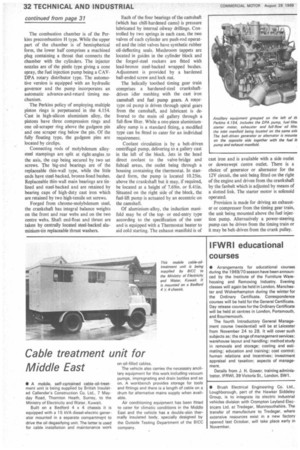Fill-the-bill diesel from Perkins
Page 33

Page 34

If you've noticed an error in this article please click here to report it so we can fix it.
NEW 2.52 LITRE UNIT AIMED AT 22/25 CWT LIGHT VAN CLASS
by Paul Brockington • It is significant that the new Perkins 4.154 automotive four-cylinder 154 cu.in. 2.52-litre diesel announced today develops its gross "van rating" output of 62 bhp at a speed of 3,000 rpm, and that these performance characteristics match the typical requirements of vans in the 22 /25cwt category. The maximum gross torque rating of the unit is 113 lb.ft. at 2,000 rpm, while the maximum b.m.e.p. is 111 p.s.i. An agricultural version of the 4.154 was displayed at the 1968 Earls Court Show.
The gross ratings quoted are based on the output of the unit at a barometric pressure of 29.38in. of mercury and an ambient temperature of 85deg F without the fan operating and with the generator or alternator running but not charging. On the same basis, the smaller Perkins 4.108 develops 52 bhp at 4,000 rpm and 79 lb.ft. at 2,000 rpm. Specific fuel consumption figures are not available.
In line with Perkins policy to date, the 4.154 has not been rated to conform to the BS AU141 standard (which specifies a smoke level) but Perkins states that the anticipated "equivalent" BS AU141 gross rating is also 62 bhp at 3,000 rpm. The BS Standard will not be adopted until it becomes a legal necessity.
Other dimensional and performance data of the 4.154 include a bore and stroke of 34-in. and 4in. respectively, a compression ratio of 21 to 1 and a dry weight (bare engine) of 430Ib. The unit has an overall length of 23.9in. a height of 28.31in. and a width of 21.34in.
Features of the 4.154 include a high-duty cast-iron, shell-moulded cylinder block and head, a five-bearing crankshaft and helical timing gears together with a timing case that caters for mounting an exhauster or compressor above the pump drive housing. The cylinders are fitted with dry-type liners and the crankcase joint face is co-planar with the crankshaft centre line. Providing a cross flow of the coolant, the cylinder head is secured to the block with set screws.
The combustion chamber is of the Perkins precombustion H type. While the upper part of the chamber is of hemispherical form, the lower half comprises a machined plug containing a throat that connects the chamber with the cylinders. The injector nozzles are of the pintle type giving a cone spray, the fuel injection pump being a C AVDPA rotary distributor type. The automotive version is equipped with an hydraulic governor and the pump incorporates an automatic advance-and-retard timing mechanism.
The Perkins policy of employing multiple piston rings is perpetuated in the 4.154. Cast in high-silicon aluminium alloy, the pistons have three compression rings and one oil-scraper ring above the gudgeon pin and one scraper ring below the pin. Of the fully floating type, the gudgeon pins are located by circlips.
Connecting rods of molybdenum alloysteel stampings are split at right-angles to the axis, the cap being secured by two set screws. The big-end bearings are of the replaceable thin-wall type, while the little ends have steel-backed, bronze-lined bushes. Replaceable thin-wall main bearings are tinlined and steel-backed and are retained by bearing caps of high-duty cast iron which are retained by two high-tensile set screws.
Forged from chrome-molybdenum steel, the crankshaft has integral balance weights on the front and rear webs and on the two centre webs. Shaft end-float and thrust are taken by centrally located steel-backed aluminium-tin replaceable thrust washers. Each of the four beatings of the camshaft (which has chill-hardened cams) is pressure lubricated by internal oilway drillings. Controlled by two springs in each case, the two valves of each cylinder are push-rod operated and the inlet valves have synthetic rubber oil-deflecting seals. Mushroom tappets are located in guides in the cylinder block and the forged-steel rockers are fitted with lead-bronze steel-backed wrapped bushes. Adjustment is provided by a hardened ball-ended screw and lock nut.
The helically toothed timing gear train comprises a hardened-steel crankshaftdriven idler meshing with the cast iron camshaft and fuel . pump gears. A rotortype oil pump is driven through spiral gears from the camshaft, and lubricant is delivered to the main oil gallery through a full-flow filter. While a one-piece aluminiumalloy sump is a standard fitting, a modified type can be fitted to cater for an individual requirement.
Coolant circulation is by a bet-driven centrifugal pump, delivering to a gallery cast in the left of the block. Jets in the head direct coolant to the valve-bridge and fishtail areas, the outlet being through a housing containing the thermostat. In standard form, the pump is located 10.25in. above the crankshaft but it may, if required, be located at a height of 7.69in. or 8.41in. Situated on the right side of the block, the fuel-lift pump is actuated by an eccentric on the camshaft.
Of aluminium-alloy, the induction manifold may be of the topor end-entry type according to the specification of the user and is equipped with a Thermostat heater to aid cold starting. The exhaust manifold is of cast iron and is available with a side outlet or downswept centre outlet. There is a choice of generator or alternator for the 12V circuit, the unit being fitted on the right of the engine and driven from the crankshaft by the fanbelt which is adjusted by means of a slotted link. The starter motor is solenoid operated.
Provision is made for driving an exhauster or compressor from the timing gear train, the unit being mounted above the fuel injecfion pump. Alternatively a power-steering pump can be driven from the timing train or it may be belt-driven from the crank pulley.




































































































